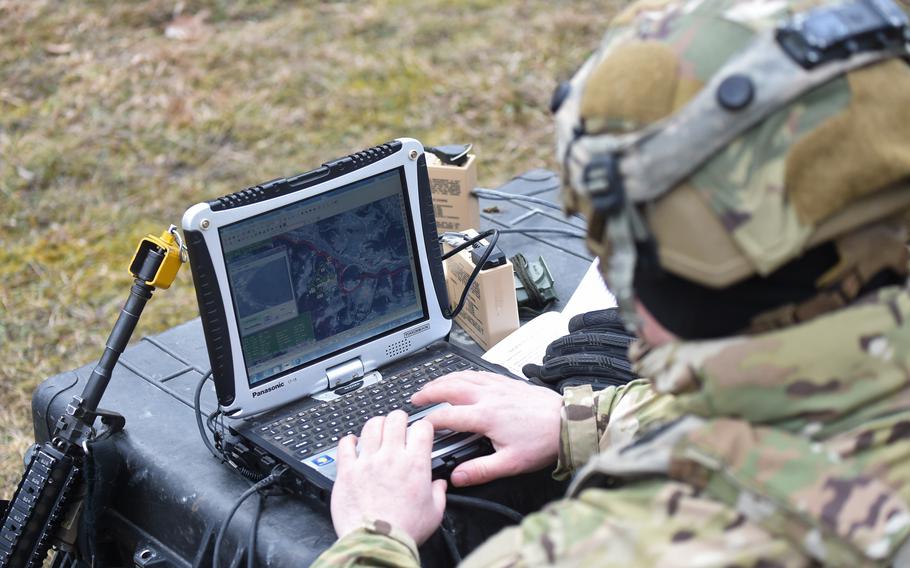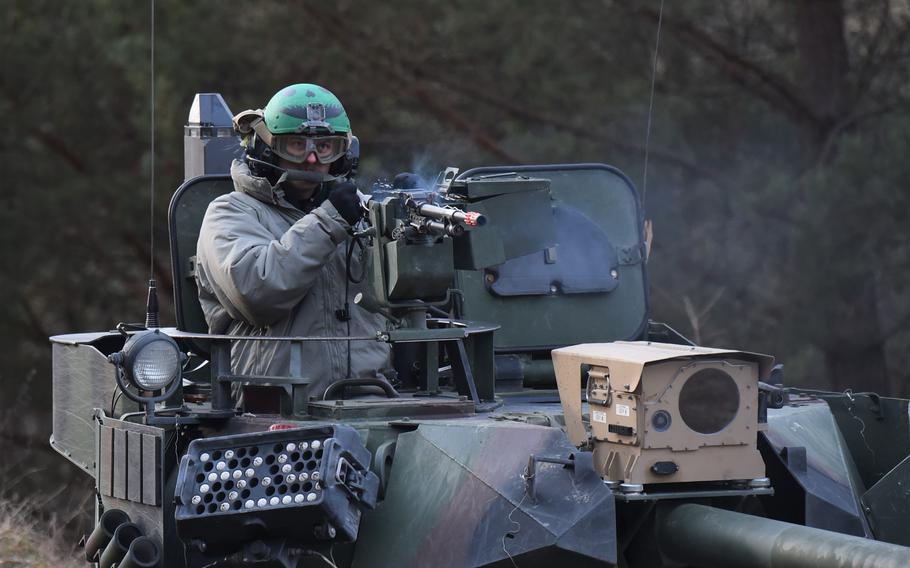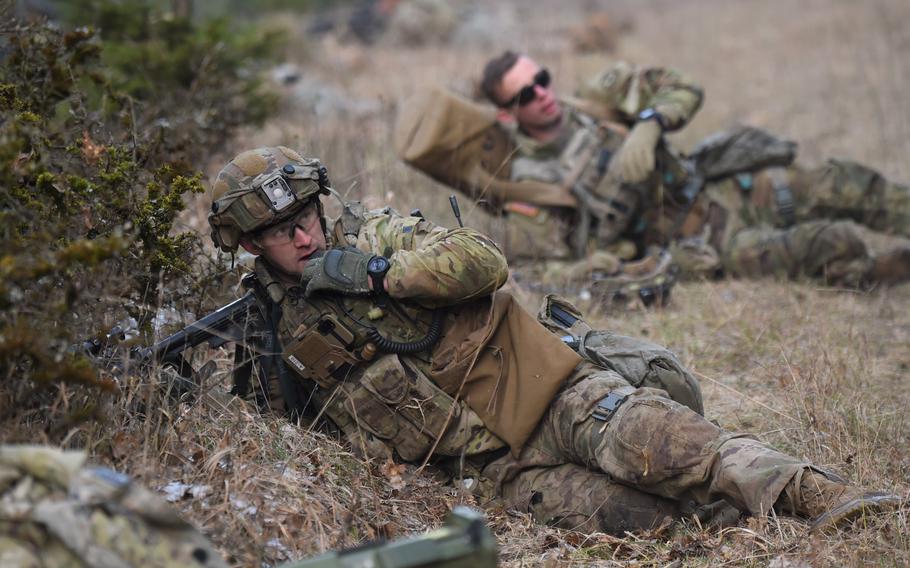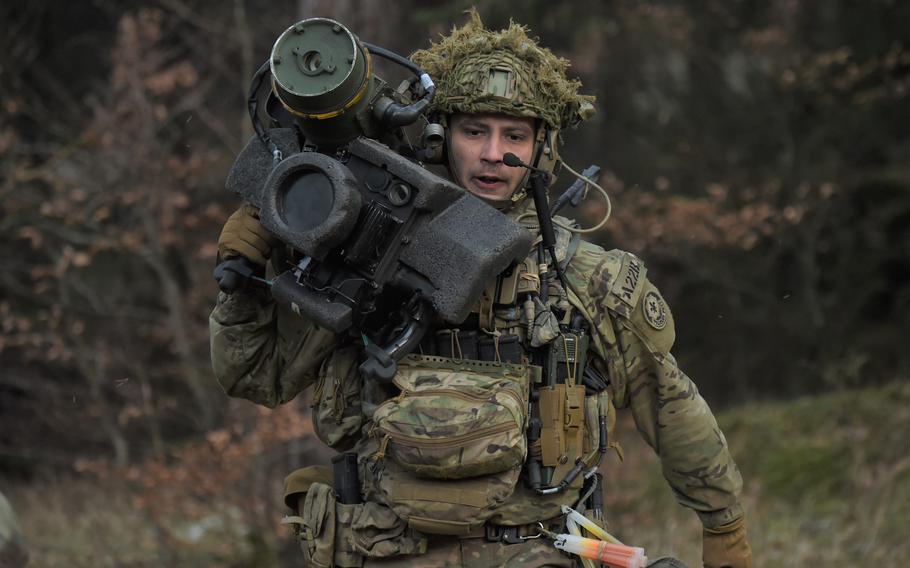
Using reconnaissance, drone team members from the 2nd Cavalry Regiment survey the battlefield and identify enemy positions during the Dragoon Ready exercise on Jan. 29, 2023, at the Joint Multinational Readiness Center training grounds in Hohenfels, Germany. (Michael Slavin/Stars and Stripes)
HOHENFELS, Germany — Gone are the days of fresh-faced lieutenants getting lost in the Bavarian woods, perhaps.
At the annual Dragoon Ready exercise, the 2nd Cavalry Regiment rolled out wearable devices connected to the Army’s Integrated Tactical Network. It shows maps and troop positions in real time and allows users to call for fire and relay intelligence.
“It’s like Google Maps combined with WhatsApp,” said Capt. Bradley Lichtfuss, commander of Apache Troop. “I can see where everyone is at, and their status. ... Before, it was like pulling teeth with an old FM radio.”
The integrated network is the new wrinkle in this year’s exercise. It’s been used by other units stateside, but the Vilseck-based 2nd Cavalry is the first unit in Europe to test the system’s capabilities.
The network functions across an array of devices and eventually will put large-scale communications on a single platform.

Enemy vehicles simulate fire on the 2nd Cavalry Regiments ground soldiers during ambush training, as part of exercise Dragoon Ready on Jan. 29, 2023, at the Joint Multinational Readiness Center in Hohenfels, Germany. (Michael Slavin/Stars and Stripes)
Lichtfuss said the network lets troops move two or three times faster in unfamiliar terrain than they normally would.
It’s operated via devices similar to cellphones, one of which can be mounted on a squad leader’s chest. The battery pack is carried on the soldier’s back and can power the devices in the field for between 17 and 20 hours.
The system runs off local cell towers, sending data to a cloud, where it’s encrypted and sent back down to command elements miles away.
“But what if they destroy all the cell towers, right?” Lichtfuss said.
In that case, the devices are capable of creating their own network with each other. If that’s not available, the devices still have built-in maps and GPS, which function as a last resort before soldiers have to rely on the Army’s long-taught land navigation skills.

Sgt. Devlin Hendrix, of the 2nd Cavalry Regiment, equipped with a device linked to the Integrated Tactical Network, communicates with soldiers during a simulated ambush, as part of the Dragoon Ready exercise on Jan. 29, 2023, at the Joint Multinational Readiness Center in Hohenfels, Germany. (Michael Slavin/Stars and Stripes)
During the Hohenfels exercise, soldiers from the regiment demonstrated a call for a medical evacuation with the devices. The task requires only a tap on a screen.
The U.S. eventually intends to give partner nations access to the technology.
“They are critical to the fight,” Undersecretary of the Army Gabe Camarillo said during a visit to Hohenfels on Wednesday. “Most importantly, we have to be able to move, shoot in coordination with our allies.”
Testing of the new technology is part of the Army’s larger two-year network modernization and fielding process. Later this year, the Army wants to extend the technology to Stryker vehicles and formations.
The 2nd Cavalry Regiment, along with NATO partners, has more than 2,800 troops participating in the Dragoon Ready exercise.

Sgt. Jacob Cavaleri of the 2nd Cavalry Regiment simulates using a Javelin to ambush enemy tanks during the Dragoon Ready exercise on Jan. 29, 2023, at the Joint Multinational Readiness Center in Hohenfels, Germany. (Michael Slavin/Stars and Stripes)